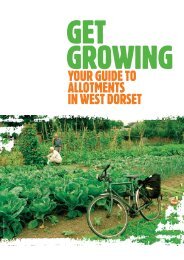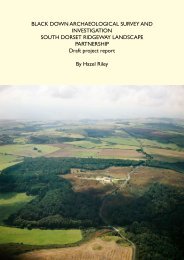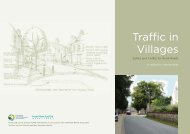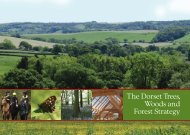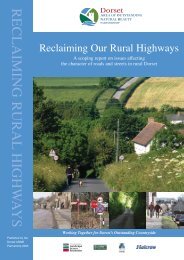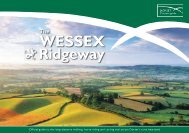3: Dorset's trees, woods & forests; Current ... - the Dorset AONB
3: Dorset's trees, woods & forests; Current ... - the Dorset AONB
3: Dorset's trees, woods & forests; Current ... - the Dorset AONB
- No tags were found...
Create successful ePaper yourself
Turn your PDF publications into a flip-book with our unique Google optimized e-Paper software.
Cardinal Beetle © Forestry Commission
<strong>Dorset</strong>’s Trees,Woods and ForestsSection 313Why Trees, Woods and Forests are importantTrees, <strong>woods</strong> and <strong>forests</strong> and <strong>the</strong>ir associated benefits(biodiversity, woodfuel, timber for construction, socialwellbeing, etc) have <strong>the</strong> ability to contribute to <strong>the</strong>improvement of 21 of <strong>the</strong> Quality of Life indicators for<strong>the</strong> South West and 39 of <strong>the</strong> 68 UK national indicatorsincluding protecting natural resources and creatingsustainable communities (Willis 2004). In addition, <strong>the</strong>area of woodland in <strong>the</strong> UK, <strong>the</strong> protection andexpansion of ancient and semi-natural woodland and<strong>the</strong> sustainable management of woodland are nationalindicators in <strong>the</strong>ir own right. Woodlands, particularlyancient woodlands are significant archaeologicalremains and should be conserved as such. Woodlandcan be a major contributor not only to UK sustainabledevelopment policy but also to policies on health,Yellow Archangel © David Reeseducation, social inclusion, rural development andbiodiversity. The Woodland Trust and National Forest objectives highlight <strong>the</strong> demand fornew woodlands to deliver environmental and socio-economic benefits.Examples of how <strong>trees</strong>, <strong>woods</strong> and <strong>forests</strong> can contribute include:• Biodiversity – woodlands, <strong>forests</strong> and <strong>trees</strong> provide habitats for a great variety of animaland plant species, many of which would not survive without <strong>the</strong>m. In particular, ancientwoodlands are enormously important as <strong>the</strong> plants and animal species have evolved anddeveloped with continuous woodland cover or traditional woodland practices suchas coppicing.• Landscape – <strong>trees</strong> and woodlands form an important component of <strong>the</strong> landscape.Wooded landscapes, such as <strong>the</strong> Marshwood Vale, ei<strong>the</strong>r directly or indirectly contributeto our quality of life. They help give landscapes a sense of place, identity, quality andsecurity which in turn promotes enjoyment, access and economic return.• Climate Change Mitigation – <strong>forests</strong> and woodlands play a vital role in <strong>the</strong> absorption ofcarbon emissions. The amount of carbon sequestered is dependent on <strong>the</strong>ir managementand wood can be used as a carbon-lean energy source. Tree species, thinning, productivityand yield class are all factors that need to be considered in <strong>the</strong> future. Woodfuel is agrowing market in <strong>Dorset</strong>.• Economics – <strong>forests</strong> and woodlands contribute to <strong>the</strong> strength of local, regional andnational economies in many different ways. Directly this is achieved through timberproduction and processing, employment opportunities, local products, rural development,and land regeneration; indirectly through landscape benefits which attract tourist revenueand local visitors. Declining income from broadleaved woodlands over <strong>the</strong> last 20 yearshas resulted in a massive reduction in resources available for work in woodlands of allkinds. However, forestry is one of a few industries based on renewable resources, and hasa vital future role in a more sustainable, low-carbon economy.• Access & Recreation – woodlands and <strong>forests</strong> are some of <strong>the</strong> most popular visitordestinations in <strong>the</strong> UK. Activities such as walking, cycling and riding can provide healthbenefits as well as enjoying a sense of tranquillity and well being to local populations.Woods and <strong>forests</strong> are increasingly being managed for a wide range of activities such asshooting, mountain biking, walking and wildlife watching, creating revenue forlandowners and associated businesses.• Education – <strong>the</strong> woodland environment provides an ideal opportunity to learn about <strong>the</strong>relationship between humans and <strong>the</strong> natural environment, and can offer all manner ofcross-curricular learning opportunities. This helps develop an awareness of <strong>the</strong> ruralenvironment and links between rural and urban environs. The development of <strong>forests</strong>chools has been a successful way of increasing education opportunities and contributingto education enabling us to appreciate our heritage and culture and live a healthier life.<strong>Dorset</strong> currently has no accredited Forest School• Communities and Places – <strong>trees</strong>, <strong>woods</strong> and <strong>forests</strong> can provide a wide range of benefitsto all sections of <strong>the</strong> community. They reduce noise and air pollution and providesustainable urban drainage and shade. They create a green infrastructure, provide a senseof ‘well-being’, inspire people, improve neighbourhoods and bring people of differentcultures, generations, backgrounds and religions toge<strong>the</strong>r for a common goal or purpose.• Water Quality – In many instances <strong>woods</strong> and <strong>forests</strong> can improve water quality andreduce <strong>the</strong> potential for flooding. Trees can stabilise slopes and riverside banks andstrategically located woodlands can protect water from diffuse pollution fromagriculture and nutrient run-off. Woodland on floodplains also has <strong>the</strong> potential tophysically ‘retain’ water in times of heavy rainfall, reducing peak flows.• Cultural and Historical Heritage – <strong>the</strong> <strong>trees</strong>, <strong>woods</strong> and forest we see today are <strong>the</strong>product of historic land management systems. Evidence suggests that humans weremanaging woodlands in <strong>the</strong> Mesolithic period. This continued management incorporatedopen space creation, coppicing, pollarding and cultivating fruit in orchards. It has given aunique identity to <strong>the</strong> cultural and historic landscape of <strong>Dorset</strong>.
Section 3HistoryThe character of <strong>Dorset</strong>’s wooded landscapes has evolved through intricate interactionsbetween nature and human activity. For centuries <strong>Dorset</strong>’s <strong>trees</strong> and woodlands have beensubject to management and been an integral part of <strong>the</strong> local economy. This has left avaluable cultural and social legacy, which must be protected and managed to provide <strong>the</strong>benefits expected from society now, and in <strong>the</strong> future.Eight thousand years ago as much as 80% of Great Britain was forest (albeit with wide openspaces grazed by large herbivores). By about two thousand years ago large-scale forestclearance for settlement and agriculture, combined with changes in <strong>the</strong> climate had alreadyresulted in tree cover falling to around 20%, with distinct regional variations. This declinecontinued through most of <strong>the</strong> next two thousand years, and by 1900, forest and woodlandcover was around 5%. People have shaped almost all of what we see today in <strong>the</strong> landscape,and many of <strong>the</strong> open spaces of <strong>the</strong> uplands and lowland heaths, as well as <strong>the</strong> layout oftowns and villages, owe much to <strong>the</strong> actions of people many centuries ago.The Doomsday Book (published in 1086) quotes <strong>Dorset</strong> as having approximately 32,800hectares (81,000 acres) of woodland, including wood pasture (Rackham 1986), slightly higherthan recent surveys of 28,758 hectares. In <strong>the</strong> Ancient Woodland Inventory, compiled andwritten by Jonathan Spencer, <strong>Dorset</strong> is quoted as having 7,749 hectares of ancient woodland.Melbury Park in North West <strong>Dorset</strong> is an outstanding example of well-treed parkland.Melbury Park was enclosed in 1547 and its continued management as a deerpark with its individual <strong>trees</strong> of great antiquity explains why it is one of <strong>the</strong> richestlocalities for epiphytic lichens in Europe.Woodland archaeology can be categorised into those remnants from an earlier, openlandscape preserved by tree cover, and those that relate to <strong>the</strong> past management of treecoveredlandscapes. From <strong>the</strong> former category, features and sites such as round barrows,burial mounds and prehistoric field systems exist in woodland. From <strong>the</strong> latter category,charcoal hearths, limekilns and brickworks inform us of past woodland management. Allform part of <strong>the</strong> historic environment and provide <strong>the</strong> tools with which we can understandour past. They are a finite, non-renewable resource, and once lost, can not be replaced. Toallow <strong>the</strong> interpretation and study of <strong>the</strong> historic environment by future generations, <strong>the</strong>ymust be managed to ensure its preservation.Throughout <strong>the</strong> centuries woodlands of <strong>Dorset</strong> were extensively managed and providedeconomic and social functions to local communities. Until <strong>the</strong> 1800s, woodlands remainedrelatively intact. Over <strong>the</strong> last 200 years woodlands have become more linked to <strong>the</strong> cycleof modern economies and a great deal of timber was felled to meet <strong>the</strong> demands of twoWorld Wars.<strong>Dorset</strong> has a history of plantations and natural regeneration of woodlands on heathlandsand o<strong>the</strong>r formerly open space. In many areas removal of <strong>trees</strong> to re-create open ground ofhigh nature conservation value has been very successful but in o<strong>the</strong>r areas mixed ‘woodedheath’ also provides suitable habitats for many species. Woods and <strong>forests</strong> that are managedsuccessfully provide not only economic benefits but also social and environmental ones aswell. The success of many species is a result of <strong>the</strong> combination of traditional managementpractices and commercial forestry providing suitable habitats for <strong>the</strong>se species and deliveringpriority Biodiversity Action Plans for endangered species.Motte & Bailey © Forestry CommissionSince 1945, <strong>the</strong> direct loss of individual <strong>trees</strong> was largely driven by agricultural policies of <strong>the</strong>time. Many veteran <strong>trees</strong> were felled to make way for new plantings as <strong>the</strong>y were thoughtto be of little value, or died due to unsympa<strong>the</strong>tic management practices such as hedgerowremoval or over-shading. In more recent times veteran <strong>trees</strong> have suffered as <strong>the</strong>y are a“Health and Safety” hazard <strong>the</strong> misconception that <strong>the</strong>se <strong>trees</strong> are dead, dying or dangerous.Between 1946 and 1975, at least half of <strong>the</strong> ancient woodlands in <strong>Dorset</strong> had lost <strong>the</strong>irancient woodland characteristics through <strong>the</strong> planting of non-native species, reduction inappropriate management and lack of economic value (Rackham, 1990.) The remaining 50%maintain many ancient woodland characteristics but many suffer from inappropriatemanagement.Commercial forestry consisting of non-native species was highly appropriate to <strong>the</strong> forestrypolicies and woodland objectives of <strong>the</strong> past. Many of <strong>the</strong>se <strong>forests</strong> have been managed verysuccessfully and are now an important capital resource for <strong>the</strong>ir owners and have continuedto be an important component of local timber industries. With <strong>the</strong> rise in <strong>the</strong> cost of15
Section 316imported timber, continuing <strong>the</strong>se commercial <strong>forests</strong> is important to maintain <strong>the</strong>production of quality timber whilst underpinning <strong>the</strong> current and emerging markets.Traditional woodland management practices, such as coppicing and pollarding helped createa wealth of biodiversity associated with <strong>the</strong> county’s <strong>trees</strong>, <strong>woods</strong> and <strong>forests</strong>. However,with <strong>the</strong> greater availability of fossil fuel, plastic and metal alternatives and ever increasingtimber imports, many coppice woodlands became redundant and today many woodlandproducts such as charcoal, hurdles, thatching spars and construction timber are importedfrom abroad because <strong>the</strong>y are cheaper. This decline in woodland management subsequentlyled to a decline in <strong>the</strong> biodiversity of <strong>Dorset</strong>’s woodlands, particularly butterfly andwoodland bird species. Many of <strong>the</strong>se remaining <strong>trees</strong> and woodlands are of ancientorigin, and remain today as protectors of numerous rare native wildlife species and habitats.The increase in deer and squirrel populations combined with inappropriate managementhas resulted in a decline in many native woodland species such as common dormouse(Muscardinus avellanarius), pearl-bordered fritillary butterfly (Boloria ephroyne), greaterand lesser horseshoe bats (Rhinolophus ferrumequinum & R. hipposideros) and <strong>the</strong> spottedflycatcher (Muscicapa striata). However, in many instances <strong>the</strong> planting and subsequentmanagement of forestry plantations has provided ideal habitats for many threatened speciessuch as bats, nightjar (Carpimulgus europaeus), smooth snake (Coronella austriaca) andDartford warbler (Sylvia undata).Ancient oak on bank in Harbins Park © Sean Cooch by kind permission of Harbins Park FarmOrchardsMany traditional orchards, especially those which are no longer actively cultivated, face<strong>the</strong> threat of neglect or removal to make way for housing developments, horse grazingor intensive arable agriculture. Traditional apple, pear, plum, cherry and nut orchards havechanged from being part of most farms to rarities in most counties. Yet <strong>the</strong>se orchardsare often <strong>the</strong> richest kinds for a huge diversity of wildlife, and vary enormously across <strong>the</strong>country, creating distinctive and historic landscapes. Traditional orchards are cultural landmarks.They are <strong>the</strong> source of genetic variety, local recipes and customs. They are home to <strong>the</strong>hundreds of varieties of apples and o<strong>the</strong>r orchard fruits and are extremely biodiverse.Forest and open heathland © David Rees
Section 3Woodland Ownership19(All tables in this chapter are derived from <strong>the</strong> latest data available from <strong>the</strong> ForestryCommission’s National Inventory of Woodlands and Trees, published in 2002.)One of <strong>the</strong> biggest issues facing <strong>the</strong> future of <strong>Dorset</strong>’s woodlands is <strong>the</strong> large number ofindividual woodland owners combined with <strong>the</strong>ir small size and fragmented nature. Thetable below shows <strong>the</strong> breakdown of woodland ownership in <strong>Dorset</strong> in comparison toregional and national figures.<strong>Dorset</strong> SW Region NationalOwnership Type Total % of Total Total % of Total Total % of TotalArea (ha) Woodland Area (ha) Area Area (ha) AreaPersonal 15,104 53.7 107,218 52.1 480,794 47.1Business 1,563 5.6 31,221 15.2 146,601 14.3Forestry/Timber business 0 0 0 0.0 7,200 0.7Charity 1,365 4.9 16,214 7.9 68,484 6.7Local Authority 1,211 4.3 6,350 3.1 61,098 6.0FE 6,512 23.2 6,868 17.5 27,302 21.7O<strong>the</strong>r Public 2,052 7.3 35,900 3.3 222,694 2.7Community/common land 0 0 130 0.1 3,732 0.4Unidentified 294 1 1,709 0.8 3,917 0.4Total 28,101 100 205,610 100 1,021,822 10077% of woodlands and <strong>forests</strong> in <strong>Dorset</strong> are outside <strong>the</strong> Forestry Commission’s ownership,and of this ‘o<strong>the</strong>r’ ownership 70% of <strong>the</strong> woodlands are in private hands. The NationalInventory of Woodlands and Trees also shows that 55% of <strong>the</strong>se woodlands are of less than100 hectares. With such a fragmented ownership, engaging with <strong>the</strong> owners of <strong>the</strong>seassets is key to ensuring a proactive approach to woodland management in <strong>the</strong> futureand delivering better economics for wood products. It is also crucial to ensuring <strong>trees</strong>, <strong>woods</strong>and <strong>forests</strong> play an ever more important role in providing social, economic and environmentalbenefits.Beefsteak fungus © Emma Brawn
Section 3<strong>Current</strong> Woodland& Tree Resource20<strong>Current</strong> Woodland and Tree ResourceThe charts below show <strong>the</strong> breakdown of woodland type, and compare <strong>the</strong> countywoodland cover to regional and national averages.<strong>Dorset</strong> % CoverSW % CoverGB % Cover60.0050.0040.00According to <strong>the</strong> most recent (2002) National Inventory of Woodlands and Trees, carried outby <strong>the</strong> Forestry Commission, <strong>Dorset</strong> has 28,758 hectares of woodland and forest over 0.1hectare.28,758 hectares equates to 11% of <strong>the</strong> total county land area and 13.5% of <strong>the</strong> totalwoodland in <strong>the</strong> South West region. Of <strong>the</strong> total woodland cover in <strong>Dorset</strong> over a quarter,or 7,749 hectares, is believed to have been wooded since 1600AD. This is a significantpercentage of Ancient Woodland and extremely important for biodiversity, culture andheritage. Within this definition of ancient woodland, 52.4% has been planted with nonnativespecies (known as Plantations on Ancient Woodland Sites or PAWS). In addition to<strong>the</strong> ancient woodland sites <strong>the</strong>re are a number of native species woodlands that have beenplanted or naturally regenerated over <strong>the</strong> last 150 years.The tables below show <strong>the</strong> woodland area by forest type, and <strong>the</strong> principal species foundwithin <strong>the</strong>se woodlands.30.0020.00% Cover<strong>Dorset</strong>’s Woodland by Forest TypeFelled 0.7%Mixed 14.6%Coppice 1.1%10.00Broadleaved 47.6%Open Space 5%Conifer Coppice-w- Broadleaved Coppice Mixed Windblow Open Space FelledStandardsBroad Forest Types0.00Conifer 30.7%Coppice-w-Standards 0.3%
Section 3Oak 13.3%Woodland Area by Principal Species(excluding coppice, felled and open areas)Beech 9.5%Sycamore 3.5%Ash 12.2%Birch 5.6%condition and biodiversity. However <strong>the</strong> county still retains a good number of importantsites sixty five woodland and parkland areas included within Sites of Special Scientific Interest(SSSI), although specific woodland SSSIs are under-represented in <strong>Dorset</strong> (M Heath, perscomm.) Two of <strong>the</strong>se areas are designated as Special Areas of Conservation (SACs). Inaddition <strong>the</strong>re are 621 woodland Sites of Nature Conservation Interest (SNCIs). All comprise6,693 hectares. In recent years more innovative silviculture practises have been adopted,such as Continuous Cover Forestry (CCF) and <strong>the</strong>re has been a resurgence of coppicing.Much of <strong>the</strong> ancient woodland cover is to be found on <strong>the</strong> clay and alluvial soils in <strong>the</strong>county although <strong>the</strong>re are a number of scattered woodlands on chalk soils. The more recentforestry conifer plantings are predominantly on <strong>the</strong> drier, sandier soils to <strong>the</strong> sou<strong>the</strong>ast of<strong>the</strong> county, whilst broadleaf plantations have been established on chalk soils.21MixedConifer 0.9%O<strong>the</strong>rConifer 12.3%Larch 2.4%Elm 0.1%O<strong>the</strong>rBroadleaves 8.1%MixedBroadleaves 8.3%Between 1995 and 2005 over 2,190 hectares were planted with <strong>trees</strong> in <strong>Dorset</strong>, with over1000 hectares being ‘new’ woodland planting, a significant increase of approximately 4%of woodland cover over <strong>the</strong> county.Pine 23.8%<strong>Dorset</strong>’s woodland cover has probably remained relatively constant since about 4,000 yearsago. Few woodlands remain that are managed sustainably and <strong>the</strong>se only account for a smallproportion of <strong>the</strong> total resource. Very few parklands or wooded commons were managedthrough history, some lasting no more than decades before going into decline. Those thatdid survive up to <strong>the</strong> World War 2 have since been grubbed out, or neglected. The fewremaining managed parklands, such as Melbury Park, Charborough Park and Stock Gaylardgive an indication of how things were. Those woodlands and parklands that remain in awell-managed condition are extremely important in <strong>the</strong>ir own right and <strong>the</strong> county isnationally recognised for its number and quality of woodland and veteran <strong>trees</strong> species.Quality UK grown timber © Forestry CommissionIn reality traditional woodland management has been in decline since <strong>the</strong> end of <strong>the</strong>19th century, and in many woodlands <strong>the</strong> lack of appropriate management and impact ofagricultural and forestry policies has been a major factor in <strong>the</strong> loss of habitat composition,
Section 322Ancient and Veteran Tree Resource<strong>trees</strong> and <strong>the</strong>ir maintenance and appropriate management is vital to <strong>the</strong>ir survival. Someindividual <strong>trees</strong> support <strong>the</strong> only known populations of particular lichen species in <strong>the</strong>county, and in a few cases in <strong>the</strong> country. O<strong>the</strong>r more common species also rely on such<strong>trees</strong> for a variety of reasons such as nesting (birds) and hibernating (bats).As well as being of considerable ecological importance, many veteran <strong>trees</strong> have significantcultural and historical value, a source of pride for many of <strong>the</strong> landowners who protect <strong>the</strong>m.Trees such as <strong>the</strong> sycamore at Tolpuddle, (where <strong>the</strong> Tolpuddle Martyrs met), two <strong>trees</strong> inBlandford known as <strong>the</strong> Bastard Bro<strong>the</strong>rs (named after two bro<strong>the</strong>rs who rebuilt <strong>the</strong> townafter <strong>the</strong> 1731 fire) and <strong>the</strong> Wyndham Oak (reputed to be over 1000 years old), are wellknown landmark <strong>trees</strong> with important cultural associations.Churchyard yew © Sean CoochInformation on <strong>the</strong> number and distribution of individual veteran <strong>trees</strong> in <strong>Dorset</strong> is limited.A report published by <strong>the</strong> <strong>Dorset</strong> Environmental Records Centre (DERC) in 2005 identifiedimportant veteran tree sites in <strong>the</strong> county (with 5 or more <strong>trees</strong>), but <strong>the</strong>re is littleinformation on number and location of individual or small groups of veteran <strong>trees</strong>. Thedata that exists is currently being updated by Natural England. The <strong>Dorset</strong> Greenwood TreeInitiative was launched in 2007 by a sub-set of <strong>Dorset</strong> Woodlink partners to address ancientand veteran tree issues. A major part of <strong>the</strong> project is to increase <strong>the</strong> number of records ofveteran <strong>trees</strong> for <strong>the</strong> county, adding to <strong>the</strong> data accumulated by DERC.<strong>Dorset</strong>’s veteran <strong>trees</strong> are a part of <strong>the</strong> internationally important veteran tree resource oflowland England. Although <strong>the</strong> information is incomplete <strong>Dorset</strong> probably supportsapproximately 5% of <strong>the</strong> South West’s resource of veteran tree wood pasture and parkland(Edwards 2005). They can be seen almost everywhere (urban setting, farmland, hedgerows,woodland, churchyards, gardens and parklands). Historic parklands probably support <strong>the</strong>most important numbers of veteran <strong>trees</strong> and <strong>the</strong>ir associated ecological interests. Manynationally uncommon species of fungi, invertebrates and lichens are associated with veteranBracket fungus © David ReesMany veteran <strong>trees</strong> are located in woodlands as old boundary <strong>trees</strong>, old wood pasture(consumed by plantations) or maiden <strong>trees</strong>. One of <strong>the</strong>ir major threats is a lack ofunderstanding about <strong>the</strong>ir management, <strong>the</strong>ir mechanics and general care. As woodlandedge, hedgerow or field <strong>trees</strong> <strong>the</strong>y can suffer from <strong>the</strong> effects of pesticides and fertilisers,shading, root damage from cultivation and soil compaction and changes in water table. Inplantations <strong>the</strong>y can suffer from <strong>the</strong> effects of forestry operations including planting tooclose, structural damage by harvesting operations and root damage from harvesting machinery.There are a number of issues facing ancient and veteran <strong>trees</strong>, which by <strong>the</strong>ir nature are oldand show signs of decay. With care <strong>the</strong>se <strong>trees</strong> will live for many years, but in <strong>the</strong> meantime<strong>the</strong> next generation need to be identified and managed appropriately.
Section 324Accessible woodlandsOver 50% of woodlands and <strong>forests</strong> in <strong>Dorset</strong> are accessible by public rights of way orpermissive access for a distance of 100 metres or more, but <strong>the</strong> majority of <strong>the</strong>se can only beeasily reached by car or some o<strong>the</strong>r form of motorised transport. Only 12.35% of <strong>Dorset</strong>’spopulation has access to woodlands over 2ha in size within 500 metres of where <strong>the</strong>y live(Woodland Trust 2004).Only 26% of schools are within 500 metres (walking distance) of an accessible woodland andwhilst <strong>the</strong> majority of smaller towns and villages are within walking distance of a woodlandor forest, <strong>the</strong> bigger urban areas have little or no accessible woodland within walkingdistance.As populations grow <strong>the</strong>re is a need to identify and encourage multi-functional woodlandareas to meet <strong>the</strong> increasing need for recreational opportunities. Woodland habitats tend tobe more ‘robust’ than some o<strong>the</strong>r habitat types, and when in a peri-urban landscape <strong>the</strong>y arecapable of absorbing high numbers of people and <strong>the</strong>ir associated pressures.Horse riding in woodland © Forestry CommissionDiscussing all ability access © Forestry CommissionWoodlands that are accessible to <strong>the</strong> public, both urban and rural, are significant in that <strong>the</strong>yprovide places where people feel <strong>the</strong>y can get away from <strong>the</strong> stresses of everyday life.Woodlands and <strong>trees</strong> have an important role to play in <strong>the</strong> physical, mental and spiritualwellbeing of people, and <strong>the</strong> health impacts of well designed woodlands can be extremelybeneficial. Engaging communities with local woodland design and management can developa sense of pride in <strong>the</strong> <strong>woods</strong>, ensuring that <strong>the</strong> <strong>woods</strong> stay as a place for peaceful andsociable recreation.



